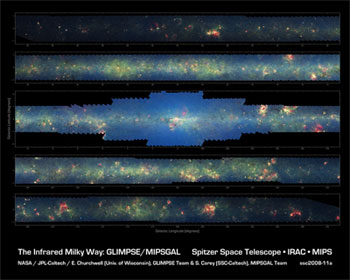June 6, 2008 --
It’s the Milky Way like you’ve never seen it before – in infrared.
Thanks to the Spitzer Space Telescope, the Galactic Legacy Infrared Mid-Plane Survey Extraordinaire (GLIMPSE) team captured 800,000 frames with the telescope's infrared array camera to see light from newborn stars, old stars and polycyclic aromatic hydrocarbons. A second group, the Multiband Imaging Photometer for Spitzer Galactic Plane Survey (MIPSGAL) team, imaged dust in the inner galaxy with Spitzer's multiband imaging photometer.
As inhabitants of a flat galactic disk, Earth and its solar system have an edge-on view of their host galaxy, like looking at a glass dish from its edge. From our perspective, most of the galaxy is condensed into a blurry narrow band of light that stretches completely around the sky, also known as the galactic plane.
At visible wavelengths, we can only see about 5 percent of the way through the galaxy on average, due to the opaqueness of the dust particles distributed throughout the galaxy. In the infrared, not only are these dust particles less opaque, but the heated dust radiates infrared radiation, announcing its presence. These surveys have 100 times the sensitivity and over 10 times the resolution of previous infrared surveys, allowing us to see stars and dusty objects throughout most of the galaxy for the very first time.

In this mosaic the galactic plane is broken up into five components: the far-left side of the plane (top image); the area just left of the galactic center (second to top); galactic center (middle); the area to the right of galactic center (second to bottom); and the far-right side of the plane (bottom). From Earth, the top two panels are visible to the northern hemisphere, and the bottom two images to the southern hemisphere. Together, these panels represent more than 50 percent of our entire Milky Way galaxy.
The swaths of green represent organic molecules, called polycyclic aromatic hydrocarbons, which are illuminated by light from nearby star formation, while the thermal emission, or heat, from warm dust is rendered in red. Star-forming regions appear as swirls of red and yellow, where the warm dust overlaps with the glowing organic molecules. The blue specks sprinkled throughout the photograph are Milky Way stars. The bluish-white haze that hovers heavily in the middle panel is starlight from the older stellar population towards the center of the galaxy.
This is a three-color composite that shows infrared observations from two Spitzer instruments. Blue represents 3.6-micron light and green shows light of 8 microns, both captured by Spitzer's infrared array camera. Red is 24-micron light detected by Spitzer's multiband imaging photometer.
This 5-gigapixel image of the Milky Way is the largest that we have seen to date, and considering the vastness of the universe, these images will most certainly prove to be a mere brushstroke in grander portrait of what’s to come.
For more information, visit:
http://www.astro.wisc.edu/sirtf/